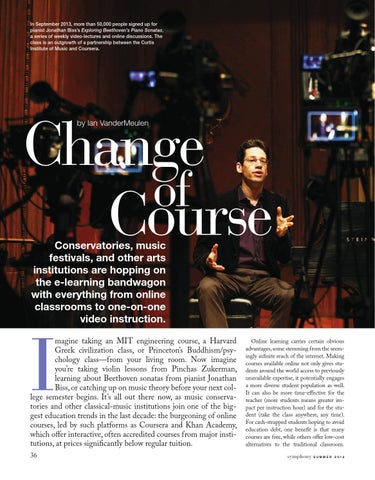In September 2013, more than 50,000 people signed up for pianist Jonathan Biss’s Exploring Beethoven’s Piano Sonatas, a series of weekly video-lectures and online discussions. The class is an outgrowth of a partnership between the Curtis Institute of Music and Coursera.
Change of Course by Ian VanderMeulen
Conservatories, music festivals, and other arts institutions are hopping on the e-learning bandwagon with everything from online classrooms to one-on-one video instruction.
I
magine taking an MIT engineering course, a Harvard Greek civilization class, or Princeton’s Buddhism/psychology class—from your living room. Now imagine you’re taking violin lessons from Pinchas Zukerman, learning about Beethoven sonatas from pianist Jonathan Biss, or catching up on music theory before your next college semester begins. It’s all out there now, as music conservatories and other classical-music institutions join one of the biggest education trends in the last decade: the burgeoning of online courses, led by such platforms as Coursera and Khan Academy, which offer interactive, often accredited courses from major institutions, at prices significantly below regular tuition. 36
Online learning carries certain obvious advantages, some stemming from the seemingly infinite reach of the internet. Making courses available online not only gives students around the world access to previously unavailable expertise, it potentially engages a more diverse student population as well. It can also be more time-effective for the teacher (more students means greater impact per instruction hour) and for the student (take the class anywhere, any time). For cash-strapped students hoping to avoid education debt, one benefit is that many courses are free, while others offer low-cost alternatives to the traditional classroom. symphony
SUMMER 2014
